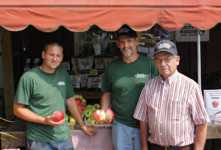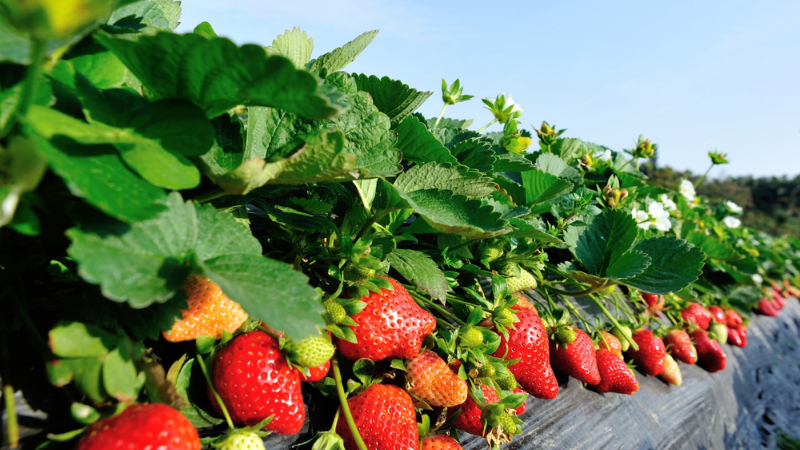High Tunnels At Weaver’s Orchard

Since its inception, Weaver’s Orchard has evolved into a business that thrives on connecting with its customers. In the early years of the operation, most of the fruit grown there was marketed to local towns and eventually area farmers markets. Today, the focus is on direct marketing. “Our vision is to sell as much as we can direct to the consumer, and that’s mostly done through pick your own and through our farm market that’s on location here,” operations manager Ed Weaver says.
Most of the farm’s acreage is in tree fruit, but Weaver’s does grow some berries, as well as a few vegetable crops, including asparagus, pumpkins, and tomatoes. To thoroughly supply the on-site market, they purchase some vegetables from other local growers, as well.
Tunnel Vision
In 2003, Weaver’s put up its first high tunnel for growing sweet cherries. “At that point in time, we were frustrated with growing cherries and had lost numerous crops to rain cracking. We were looking for another option or we were going to get out of growing cherries,” says Ed’s son, Justin Weaver, production manager. And because the consumer is always top of mind for Weaver’s, they wanted to make sure they had a consistent, high-quality product to offer.
Today, nearly 5 acres of crops are grown in high tunnels, Justin says.
The tunnels not only save the cherries from rain cracking, they extend the season, too, by about five days, according to Justin. “It’s not an extreme extension, but every little bit does make a difference,” he says.
Weaver’s does still grow some of its cherries outside, and Justin says there is a definite difference in quality between those grown outside and those grown in high tunnels, especially during wet seasons, like this year. “With the cherries in the tunnel, there was less disease, less cracking in the fruit, and just altogether a better quality cherry, and it was very easy to see the difference,” Justin says. “And also, outside the tunnels we probably lost an average of 40% to 50% of our crop, whereas in the tunnels we had a little bit of loss from high humidity, but it was very minimal.”
One of the disadvantages of the tunnels, Justin says, is that because of the drier environment, sometimes insects can become more of a problem. Pollination has been somewhat of a challenge, too. “It’s a little bit more of a challenge to get the bees to move around between the trees,” Justin says. But switching from honeybees to bumblebees has helped. “It’s been better the last couple of years since we’ve been using bumblebees, because the honeybees get lost,” he explains.
Irrigation can be challenging, as well, Justin notes. “When you keep the rain out, it’s more difficult to irrigate,” he says. “The irrigation works, but it’s not as good as rain for getting water to the trees.”
However, both Justin and Ed agree that the positives of high tunnels far outweigh the negatives. “I think for our operation, being a direct marketing operation, it’s important that we have consistent supply from year to year in order to maintain our customer base, especially with the PYO, and that’s one of the things the high tunnels have helped to ensure — that our customers know we’re going to have good sweet cherries that are not cracked or rotted,” Ed says.
He adds that because of high tunnels, Weaver’s has had a much better tomato crop this year than many of the growers in the Northeast who have been dealing with late blight. “Because we grow our tomatoes under high tunnels, we were able to avoid that problem and provide our customers a good, high-quality tomato, so I think especially when you’re a direct marketing type of operation, the high tunnels have value,” he says.
On top of that, the tunnels provide protection from the rain, so customers who want to pick their own fruit can come even on a rainy day and know they won’t have to get wet. The other point to make, Ed adds, is that the tunnels mean work can continue on the trees, even during inclement weather. “If it’s raining, any time of year here, there’s often work that needs to be done in a high tunnel somewhere, so when it’s raining, the work continues and the sales continue,” he says.
Customer Connections
While just about every business struggles during a down economy, strong management and a constant focus on the customer have kept Weaver’s on track. “When you run into an economy like we have now, it forces you to just keep a closer track of expenses and make sure that with the supplies you’re buying in — you’re getting the best price,” Ed says.
Emphasizing the benefits of buying local has kept sales strong for Weaver’s, too. “There’s still that emphasis on being able to get a fresh product direct from the grower, and even though the economy is tight, they [consumers] continue to worry about that, I think especially with some of the food safety concerns that we have today,” Ed says.
That’s just one of many reasons why Ed and Justin hope to expand the on-site market in the future. “We’ve kind of reached a lid as to how much we can grow in the current facility,” Ed says. Ultimately, he’d like to move the market to a different part of the farm, building a new facility that’s more visible to people driving through the area.
In addition, the plan is to continue to focus on direct marketing, growing the PYO business, possibly to include even more acres of additional crops conducive to PYO. That’s where the Weavers see the most potential for growth — further developing their customer connections. “We’re not only selling the product — we’re selling the experience, and that’s something that people value,” Ed says. “It’s hard to put a price tag on an experience.”










